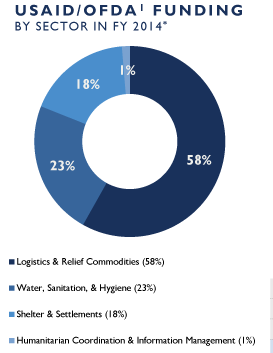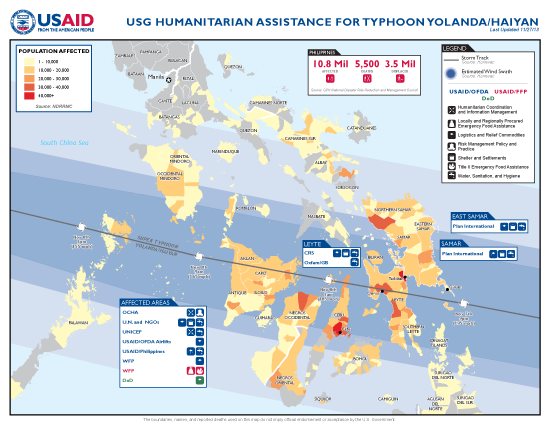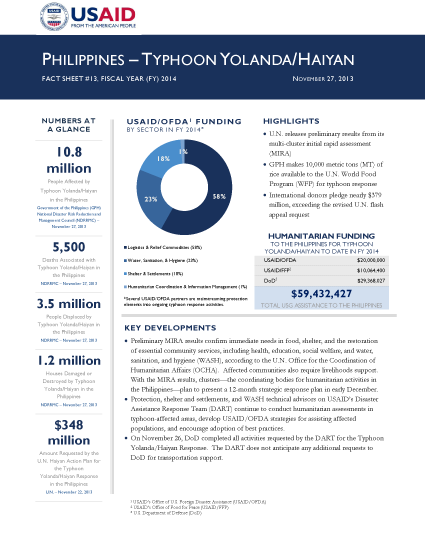- What We Do
- Agriculture and Food Security
- Democracy, Human Rights and Governance
- Economic Growth and Trade
- Education
- Ending Extreme Poverty
- Environment and Global Climate Change
- Gender Equality and Women's Empowerment
- Global Health
- Water and Sanitation
- Working in Crises and Conflict
- Disaster Assistance
- Political Transition Initiatives
- Conflict Mitigation and Prevention
- Countering Violent Extremism
- Disaster Risk Reduction
- Peacebuilding and Reconciliation
- Providing Safe & Secure Environments for Development
- Recovering From Crisis
- Resilience
- Tech Challenge for Atrocity Prevention
- World Humanitarian Day
- U.S. Global Development Lab
November 27, 2013
Numbers At A Glance
10.8 million
5,500
3.5 million
1.2 million
$348 million
Humanitarian Funding:
To The Philippines For Typhoon Haiyan/Yolanda To Date In FY2014:

| USAID/OFDA | $20,000,000 |
| USAID/FFP | $10,064,400 |
| DoD | $29,368,027 |
| TOTAL | $59,432,427 |
Typhoon Haiyan / Yolanda Fact Sheet #13 - 11/27/2013 ![]() (pdf - 219k)
(pdf - 219k)
Highlights
U.N. releases preliminary results from its multi-cluster initial rapid assessment.
(MIRA) GPH makes 10,000 metric tons (MT) of rice available to the U.N. World Food Program (WFP) for typhoon response.
International donors pledge nearly $379 million, exceeding the revised U.N. flash appeal request.
Key Developments
Preliminary MIRA results confirm immediate needs in food, shelter, and the restoration of essential community services, including health, education, social welfare, and water, sanitation, and hygiene (WASH), according to the U.N. Office for the Coordination of Humanitarian Affairs (OCHA). Affected communities also require livelihoods support. With the MIRA results, clusters—the coordinating bodies for humanitarian activities in the Philippines—plan to present a 12-month strategic response plan in early December.
Protection, shelter and settlements, and WASH technical advisors on USAID's Disaster Assistance Response Team (DART) continue to conduct humanitarian assessments in typhoon-affected areas, develop USAID/OFDA strategies for assisting affected populations, and encourage adoption of best practices.
On November 26, DoD completed all activities requested by the DART for the Typhoon Yolanda/Haiyan Response. The DART does not anticipate any additional requests to DoD for transportation support.
LOGISTICS AND RELIEF COMMODITIES
- USAID partner WFP continues to improve the delivery of relief items and widen the geographic reach of humanitarian assistance, delivering rice and high-energy biscuits to remote island communities off the coasts of Guiuan municipality and Iloilo Province. WFP trucks are also delivering bulk rice rations to most-affected coastal communities in Eastern Samar Province, including Guiuan.
- As of November 27, WFP had transported approximately 1,000 metric tons (MT) of humanitarian cargo by air, road, and sea on behalf of humanitarian organizations. As of November 26, the U.N. Humanitarian Air Service (UNHAS) had transported 292 humanitarian passengers and nearly 2.5 MT of humanitarian cargo via 70 flights to nine locations. UNHAS continues to operate one fixed-wing aircraft and two medium-sized helicopters out of Cebu.
- The Logistics Cluster reports that surface transport remains the most cost-effective means of transporting cargo from Manila to Tacloban. In addition, surface transport decreases congestion at airports and seaports and eliminates the need for equipment and skilled laborers to offload cargo.
PROTECTION
- The Protection Cluster estimates that 42 percent of affected people have documentation needs, 40 percent are experiencing problems communicating with separated family members due to power outages and disrupted communications systems, and 20 percent have security concerns.
- Humanitarian partners are establishing women-friendly spaces in strategic locations to address the needs of women and adolescent girls, according to OCHA. Partners are also establishing child-friendly spaces, conducting information sessions on gender-based violence, and providing hygiene materials to meet the specific needs of women and girls.
Health and Water, Sanitation, and Hygiene (WASH)
- The GPH Department of Health (DoH) and the U.N. World Health Organization (WHO) began a vaccination campaign—in coordination with the U.N. Children’s Fund (UNICEF) and other Health Cluster partners—in Tacloban on November 26. The campaign will vaccinate children under five years of age against measles and polio, as well as provide vitamin A supplements.
- Dengue and chikungunya—mosquito-borne viruses—are endemic throughout typhoon-affected areas, and massive debris piles are likely increasing breeding areas for mosquitos, according to the DART WASH advisor. The GPH has considered the islands of Leyte and Samar malaria-free for 10 years; however, health partners have expressed concern that population movements and the interruption of mosquito control campaigns could result in the re-introduction of malaria. Health officials also remain concerned about leptospirosis, a bacterial disease present in affected areas.
- The DoH, WHO, and vector-borne disease specialists continue to assess the vector-borne disease surveillance system. In addition, Health Cluster partners have initiated disease-prevention campaigns and are conducting capacity building activities to strengthen the ability of local health facilities to respond in the event of an outbreak.
- Health facilities in affected areas report that most patients are being treated for wound infections, upper respiratory tract infections, and diarrhea. The DoH and non-governmental organizations (NGOs) report that additional health activities—including family planning services and services for people with disabilities—have begun in affected areas.
- OCHA reports that 153 foreign, national, and local medical teams are providing emergency health services, supplies, and equipment in affected areas. Health Cluster partners have delivered tents, generators, cold chain equipment, medicine, and body bags to priority health facilities.
SHELTER AND SETTLEMENTS
- Between November 22 and 24, the DART shelter and settlements advisor traveled to Leyte Province to assess humanitarian conditions in Tacloban city and nearby communities. While housing damage and destruction is widespread in assessed areas, the DART advisor reports that repairs could render a significant portion of homes habitable and safe in a relatively expeditious manner. The DART advisor observed widespread self-recovery efforts, indicating a high level of resilience among affected populations. Comprehensive analysis on typhoon-related shelter needs is still pending.
- The DART advisor reports that roads are clear, crews are removing debris from waterways, and affected populations are cleaning up and moving debris into the streets for collection by large equipment, such as front loaders and trucks. Nearly all affected communities have established disposal dump sites, and larger communities are creating debris management sites next to existing disposal sites to expedite sorting and salvaging of debris. Despite recent progress, the DART advisor notes that considerable works remains in debris removal.
- USAID/OFDA has provided more than $3.1 million to date to two partners to provide technical assistance along with shelter kits to help more than 148,000 people rebuild safer, more durable shelters, and airlifted plastic sheeting sufficient for 20,000 families from its relief supply warehouse in Dubai, United Arab Emirates.
FOOD SECURITY AND NUTRITION
- WFP has reached an agreement with the GPH National Food Authority to make 10,000 MT of rice available for the typhoon response. WFP plans to begin loading the first portion of rice for transport to Leyte and Samar islands on November 27.
- WFP has pre-positioned Plumpy’doz, a ready-to-eat supplementary food, in Tacloban and Guiuan to help prevent acute malnutrition among vulnerable children between six and 23 months. Nutrition Cluster partners estimate that nearly 1.4 million children under five years of age, approximately 650,000 pregnant and lactating women, and more than 800,000 elderly people in affected areas are at risk of acute malnutrition.
INTERNATIONAL ASSISTANCE
- As of November 27, international donors had pledged nearly $379 million to address the needs of populations affected by Typhoon Yolanda/Haiyan. The total amount pledged exceeds the $348 million requested by the revised U.N. Haiyan Action Plan for the Philippines typhoon response.









Comment
Make a general inquiry or suggest an improvement.